The Mil & Aero Blog
Friday, February 29, 2008
Destroyer diplomacy: USS Cole brings symbolic punch to tense Middle East
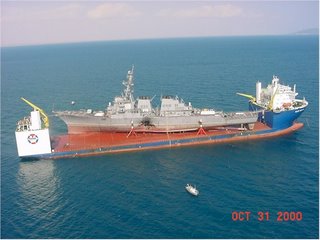
Posted by John Keller
It's a time-honored tradition among world powers to send warships to politically volatile regions around the world as symbols of stability and naval might. The term that describes this phenomenon is Gunboat Diplomacy, and it's been part of the global political landscape for more than 200 years.
The latest "gunboat" in this continuing tradition is the United States guided missile destroyer USS Cole, which is being dispatched off the coast of Lebanon in the Eastern Mediterranean as a deterrent to outside meddling in the internal politics of Lebanon. The chief suspect is Syria.
Ordinarily yet-another manifestation of Gunboat Diplomacy wouldn't be worthy of comment -- perhaps not even of notice -- but for the choice of the vessel this time, the USS Cole. Certainly this warship has more symbolic value than real hitting power. This ship is a destroyer, after all. It's not as though the Cole packs the punch of an aircraft carrier.
But let's remember the role of the USS Cole in the war on terror. This ship was on the front lines even before most people had recognized a war on terror. Even before the 9/11 jetliner attacks on the Twin Towers, the Cole was a casualty of an al-Qaida attack in Yemen when a small boat full of explosives and suicide bombers blew a hole in the Cole's side big enough to drive an SUV through.
That attack was 12 Oct. 2000 -- 11 months before 9/11 -- and it killed 17 members of the Cole's crew, and wounded 39 others. This vessel was an early symbol of the war on terror, and endures so to this day.
Let's glance at the Cole's power in a purely military sense. It's an Arleigh Burke-class destroyer, gas turbine powered, with land- and sea-attack Tomahawk cruise missiles, Harpoon anti-ship missiles, Standard SM-2 anti-aircraft missiles, MK 32 torpedoes, one 5-inch gun, two 25-millimeter machine guns, four .50 caliber machine guns, and a Phalanx Gatling gun for self defense.
Suffice it to say that, relative to other U.S. Navy warships, the USS Cole isn't exactly one of the most heavily armed and intimidating vessels on the ocean.
But think of this ship's symbolic value in the Middle East. Unlike many other vessels, this one has already been bloodied in battle. If things get dicey while the Cole is on patrol off Lebanon, moreover, do you suppose that ship's crew might be in the mood for a little payback?
The accompanying photo is of the USS Cole being readied for repairs after the October 2000 terrorist attack.

Posted by John Keller
It's a time-honored tradition among world powers to send warships to politically volatile regions around the world as symbols of stability and naval might. The term that describes this phenomenon is Gunboat Diplomacy, and it's been part of the global political landscape for more than 200 years.
The latest "gunboat" in this continuing tradition is the United States guided missile destroyer USS Cole, which is being dispatched off the coast of Lebanon in the Eastern Mediterranean as a deterrent to outside meddling in the internal politics of Lebanon. The chief suspect is Syria.
Ordinarily yet-another manifestation of Gunboat Diplomacy wouldn't be worthy of comment -- perhaps not even of notice -- but for the choice of the vessel this time, the USS Cole. Certainly this warship has more symbolic value than real hitting power. This ship is a destroyer, after all. It's not as though the Cole packs the punch of an aircraft carrier.
But let's remember the role of the USS Cole in the war on terror. This ship was on the front lines even before most people had recognized a war on terror. Even before the 9/11 jetliner attacks on the Twin Towers, the Cole was a casualty of an al-Qaida attack in Yemen when a small boat full of explosives and suicide bombers blew a hole in the Cole's side big enough to drive an SUV through.
That attack was 12 Oct. 2000 -- 11 months before 9/11 -- and it killed 17 members of the Cole's crew, and wounded 39 others. This vessel was an early symbol of the war on terror, and endures so to this day.
Let's glance at the Cole's power in a purely military sense. It's an Arleigh Burke-class destroyer, gas turbine powered, with land- and sea-attack Tomahawk cruise missiles, Harpoon anti-ship missiles, Standard SM-2 anti-aircraft missiles, MK 32 torpedoes, one 5-inch gun, two 25-millimeter machine guns, four .50 caliber machine guns, and a Phalanx Gatling gun for self defense.
Suffice it to say that, relative to other U.S. Navy warships, the USS Cole isn't exactly one of the most heavily armed and intimidating vessels on the ocean.
But think of this ship's symbolic value in the Middle East. Unlike many other vessels, this one has already been bloodied in battle. If things get dicey while the Cole is on patrol off Lebanon, moreover, do you suppose that ship's crew might be in the mood for a little payback?
The accompanying photo is of the USS Cole being readied for repairs after the October 2000 terrorist attack.
Wednesday, February 27, 2008
Autonomous arms race: gentlemen, start your robots

Posted by John Keller
Lots of people have felt queasy about monster robots ever since they saw that cinematic classic Forbidden Planet, made half a century ago with its mechanical star Robby the Robot. The I, Robot movie with Will Smith a few years ago didn't make these folks feel much better.
I admit that it can be fun to see creepy robots at the movies, but I think it's important to acknowledge a clear difference between monster movie robots and today's generation of unmanned vehicles.
Autonomous vehicles such as the U.S. MQ-1 Predator and MQ-9 Reaper unmanned aerial vehicles can do destructive things -- like finding and killing terrorists before they can kill coalition soldiers. It doesn't necessarily follow that since these machines can do destructive things, that they post unacceptable risks to humanity.
Someone should tell this to a university professor in Sheffield, England, named Noel Sharkey, who in a keynote address to the Royal United Services Institute (RUSI) is warning of the threat posed to humanity by new robot weapons being developed by powers worldwide.
A University of Sheffield news release, headlined Killer military robots pose latest threat to humanity, lays out Professor Sharkey's case, which essentially boils down to these points:
-- we are beginning to see the first steps towards an international robot arms race;
-- robots may become standard terrorist weapons to replace the suicide bomber;
-- the United States is giving priority to robots that will decide on where, when, and whom to kill;
-- robots are easy for terrorists to copy and manufacture;
-- robots have difficulty discriminating between combatants and innocents; and
-- it's urgent for the international community to assess the risks of robot weapons.
It's pretty easy to see where this line of reasoning is going: robots can do bad things, therefore we ought to consider banning them. I just don't follow the logic. It's the same argument as the one for banning guns, which basically says that guns kill; ban guns and nobody gets killed.
That argument obviously doesn't wash. Banning guns succeeds only in disarming law-abiding citizens, and leaving them at the mercy of criminals who don't particularly care if there's a law prohibiting them from having guns or not. The bad guys get guns no matter what.
It's the same thing with autonomous vehicles. Ban them, and only the criminal terrorists will have them. Law-abiding countries would be at a disadvantage.
Let's look at Professor Sharkey's line of reasoning point by point. Let's consider that we could be in the beginning of an international robot arms race. No way to prevent this, and so what if we are? No weapon has ever been invented that wasn't put to use. Trying to prevent the spread of robot technology would be like trying to prevent the spread of the automobile. People want 'em, they'll get 'em.
Second point: robots may become terrorist weapons to replace the suicide bomber. Let's remember that Muslim suicide bombers get 72 virgins in heaven if they succeed in blowing themselves up. I doubt if they'll want to share those virgins with robots.
Next point: the U.S. is giving priority to robots that will decide on where, when, and whom to kill. Little chance of this. The so-called doctrine of "man in the loop" is part of the fabric of military procedures. People make the kill decisions, not the robots. Besides, everyone these days is scared to death of lawsuits. No robot manufacturer or user would allow his machines to have sole control over life-and-death decisions.
How about the claim that robots have difficulty discriminating between combatants and innocents? See paragraph above.
Let's consider that robots are easy for terrorists to copy and manufacture. Okay, so are guns, knives, personal computers, and can openers. Look what the terrorists have done with improvised explosive devices. They're pretty good at it, but U.S. forces and their allies are dealing with this threat. Plus, anything the terrorists build, we can build better. Let the robot races begin!
Last point: it's urgent for the international community to assess the risks of robot weapons. Get the U.N. involved in autonomous vehicle policy? No, thanks. I spent 10 years as a reporter in Washington watching the federal government screw up nearly everything it touched. The U.N. is even worse.
With apologies to Professor Sharkey, I think we should tend to our robots, and let the other guys tend to theirs.

Posted by John Keller
Lots of people have felt queasy about monster robots ever since they saw that cinematic classic Forbidden Planet, made half a century ago with its mechanical star Robby the Robot. The I, Robot movie with Will Smith a few years ago didn't make these folks feel much better.
I admit that it can be fun to see creepy robots at the movies, but I think it's important to acknowledge a clear difference between monster movie robots and today's generation of unmanned vehicles.
Autonomous vehicles such as the U.S. MQ-1 Predator and MQ-9 Reaper unmanned aerial vehicles can do destructive things -- like finding and killing terrorists before they can kill coalition soldiers. It doesn't necessarily follow that since these machines can do destructive things, that they post unacceptable risks to humanity.
Someone should tell this to a university professor in Sheffield, England, named Noel Sharkey, who in a keynote address to the Royal United Services Institute (RUSI) is warning of the threat posed to humanity by new robot weapons being developed by powers worldwide.
A University of Sheffield news release, headlined Killer military robots pose latest threat to humanity, lays out Professor Sharkey's case, which essentially boils down to these points:
-- we are beginning to see the first steps towards an international robot arms race;
-- robots may become standard terrorist weapons to replace the suicide bomber;
-- the United States is giving priority to robots that will decide on where, when, and whom to kill;
-- robots are easy for terrorists to copy and manufacture;
-- robots have difficulty discriminating between combatants and innocents; and
-- it's urgent for the international community to assess the risks of robot weapons.
It's pretty easy to see where this line of reasoning is going: robots can do bad things, therefore we ought to consider banning them. I just don't follow the logic. It's the same argument as the one for banning guns, which basically says that guns kill; ban guns and nobody gets killed.
That argument obviously doesn't wash. Banning guns succeeds only in disarming law-abiding citizens, and leaving them at the mercy of criminals who don't particularly care if there's a law prohibiting them from having guns or not. The bad guys get guns no matter what.
It's the same thing with autonomous vehicles. Ban them, and only the criminal terrorists will have them. Law-abiding countries would be at a disadvantage.
Let's look at Professor Sharkey's line of reasoning point by point. Let's consider that we could be in the beginning of an international robot arms race. No way to prevent this, and so what if we are? No weapon has ever been invented that wasn't put to use. Trying to prevent the spread of robot technology would be like trying to prevent the spread of the automobile. People want 'em, they'll get 'em.
Second point: robots may become terrorist weapons to replace the suicide bomber. Let's remember that Muslim suicide bombers get 72 virgins in heaven if they succeed in blowing themselves up. I doubt if they'll want to share those virgins with robots.
Next point: the U.S. is giving priority to robots that will decide on where, when, and whom to kill. Little chance of this. The so-called doctrine of "man in the loop" is part of the fabric of military procedures. People make the kill decisions, not the robots. Besides, everyone these days is scared to death of lawsuits. No robot manufacturer or user would allow his machines to have sole control over life-and-death decisions.
How about the claim that robots have difficulty discriminating between combatants and innocents? See paragraph above.
Let's consider that robots are easy for terrorists to copy and manufacture. Okay, so are guns, knives, personal computers, and can openers. Look what the terrorists have done with improvised explosive devices. They're pretty good at it, but U.S. forces and their allies are dealing with this threat. Plus, anything the terrorists build, we can build better. Let the robot races begin!
Last point: it's urgent for the international community to assess the risks of robot weapons. Get the U.N. involved in autonomous vehicle policy? No, thanks. I spent 10 years as a reporter in Washington watching the federal government screw up nearly everything it touched. The U.N. is even worse.
With apologies to Professor Sharkey, I think we should tend to our robots, and let the other guys tend to theirs.
Tuesday, February 26, 2008
Rule-based expert system may help forecast terrorist behavior and attacks

Posted by John Keller
News on the terror front comes today from University of Maryland, where researchers are using fundamentals of artificial intelligence to create an experimental rule-based expert system that may help U.S. authorities forecast potential terrorist attacks and terrorist behavior.
With funding from the U.S. Air Force Office of Scientific Research in Arlington, Va., scientists from the University of Maryland Institute for Advanced Computer Studies (UMIACS) created the SOMA Terror Organization Portal, otherwise known as STOP, which also may eventually help network anti-terrorism experts around the world who are analyzing terrorist information.
SOMA stands for stochastic opponent modeling agents, which is a logical-statistical reasoning framework that uses data about past terrorist group behavior to formulate rules about the probability of terrorist acts and behavior, according to an article at Physorg.com entitled STOP terrorism software. Writes Physorg.com:
Significantly, the STOP project enables users to mark rules as useful or not, and leave comments about the rules, which might be able to help refine the system organically over time.
This sounds like a great tool in the war on terror, but I continue to worry about an over-reliance on technology like artificial intelligence. It's no substitute for experts on the ground who can gather real intelligence.
Some of the rules in the STOP system simply have to involve how terrorists can exploit easily obtainable technology like cell phones, and how they can circumvent technology by passing notes or oral instructions hand to hand, and ear to ear.
No amount of high-tech remote sensing and rule-based expert systems on their own can effectively combat old-fashioned spycraft. It is this kind of solid intelligence information that comes the old-fashioned way that anti-terrorism experts living in a high-technology world historically have not been very good at.
Let's hope that new electronic technology like the STOP system can help experts understand not only the benefits of technology, but also its limitations.

Posted by John Keller
News on the terror front comes today from University of Maryland, where researchers are using fundamentals of artificial intelligence to create an experimental rule-based expert system that may help U.S. authorities forecast potential terrorist attacks and terrorist behavior.
With funding from the U.S. Air Force Office of Scientific Research in Arlington, Va., scientists from the University of Maryland Institute for Advanced Computer Studies (UMIACS) created the SOMA Terror Organization Portal, otherwise known as STOP, which also may eventually help network anti-terrorism experts around the world who are analyzing terrorist information.
SOMA stands for stochastic opponent modeling agents, which is a logical-statistical reasoning framework that uses data about past terrorist group behavior to formulate rules about the probability of terrorist acts and behavior, according to an article at Physorg.com entitled STOP terrorism software. Writes Physorg.com:
SOMA has generated tens of thousands of rules about the likely behavior of each of about 30 groups (including major terrorist organizations such as Hezbollah, Hamas, and Hezb-I-Islami). “SOMA is a significant joint computer science and social science achievement that will facilitate learning about and forecasting terrorist group behavior based on rigorous mathematical and computational models,” said V.S. Subrahmanian, computer science professor and UMIACS director who heads the STOP project.
Significantly, the STOP project enables users to mark rules as useful or not, and leave comments about the rules, which might be able to help refine the system organically over time.
This sounds like a great tool in the war on terror, but I continue to worry about an over-reliance on technology like artificial intelligence. It's no substitute for experts on the ground who can gather real intelligence.
Some of the rules in the STOP system simply have to involve how terrorists can exploit easily obtainable technology like cell phones, and how they can circumvent technology by passing notes or oral instructions hand to hand, and ear to ear.
No amount of high-tech remote sensing and rule-based expert systems on their own can effectively combat old-fashioned spycraft. It is this kind of solid intelligence information that comes the old-fashioned way that anti-terrorism experts living in a high-technology world historically have not been very good at.
Let's hope that new electronic technology like the STOP system can help experts understand not only the benefits of technology, but also its limitations.
Monday, February 25, 2008
New materials may yield safer, more power-efficient battery power

Posted by John Keller
If there's anything that military forces can never get enough of it's electrical power. Radios, night-vision goggles, wearable computers, and rugged PDAs are heavy enough to carry into the field, but today's fighting forces have to lug along enough batteries to keep their portable electronics running. Lives can depend on reliable batteries.
It's a never-ending challenge to design batteries that have enough juice for the missions at hand, but that don't break the soldier's back in practical use. One of the latest and most promising developments in battery technology is the lithium-ion (Li-ion) cell. There is a lot of power in one of these batteries.
One problem with Li-ion batteries, however, is safety. Overcharging these batteries can convert the lithium oxide to metallic lithium, which raises the danger of overheating, or even explosion. I think most soldiers would agree, the battlefield is dangerous enough without this threat.
Now researchers in Spain and the United Kingdom are developing an electrode material that could ease concerns about exploding Li-ion batteries, and increase the power storage capacity of these batteries, as well, reports Physorg.com in a story entitled New electrodes may provide safer, more powerful lithium-ion (Li-ion) batteries. Reports Physorg.com:
The Palacin paper, entitled Towards New Negative Electrode Materials for Li-Ion Batteries: Electrochemical properties of LiNiN, is available in .pdf form for those who want to do a deep dive.
Anything that could help lighten the load will be good news to combat troops in the field. Perhaps these new batteries may become available to them before more exotic technologies that might be able to do things like generate electrical power from body heat.

Posted by John Keller
If there's anything that military forces can never get enough of it's electrical power. Radios, night-vision goggles, wearable computers, and rugged PDAs are heavy enough to carry into the field, but today's fighting forces have to lug along enough batteries to keep their portable electronics running. Lives can depend on reliable batteries.
It's a never-ending challenge to design batteries that have enough juice for the missions at hand, but that don't break the soldier's back in practical use. One of the latest and most promising developments in battery technology is the lithium-ion (Li-ion) cell. There is a lot of power in one of these batteries.
One problem with Li-ion batteries, however, is safety. Overcharging these batteries can convert the lithium oxide to metallic lithium, which raises the danger of overheating, or even explosion. I think most soldiers would agree, the battlefield is dangerous enough without this threat.
Now researchers in Spain and the United Kingdom are developing an electrode material that could ease concerns about exploding Li-ion batteries, and increase the power storage capacity of these batteries, as well, reports Physorg.com in a story entitled New electrodes may provide safer, more powerful lithium-ion (Li-ion) batteries. Reports Physorg.com:
In the new study, M. Rosa Palacín and colleagues compared the performance of Li-ion batteries made with electrodes composed of lithium nickel nitride (LiNiN) to conventional Li-ion batteries containing carbon electrodes. The new materials are more efficient than the conventional electrodes and less likely to overheat, the researchers suggest. They note that “further improvements can be envisaged by changing the reaction conditions and the processing of the electrode.”
The Palacin paper, entitled Towards New Negative Electrode Materials for Li-Ion Batteries: Electrochemical properties of LiNiN, is available in .pdf form for those who want to do a deep dive.
Anything that could help lighten the load will be good news to combat troops in the field. Perhaps these new batteries may become available to them before more exotic technologies that might be able to do things like generate electrical power from body heat.
Sunday, February 24, 2008
Could analog architectures be the next Big Thing in electronics design?
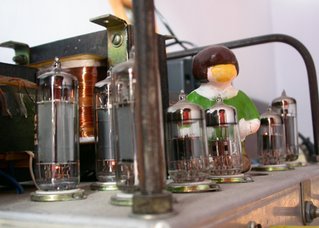
Posted by John Keller
For a long time now, analog electronic architectures have been considered black magic among mainstream systems designers. Analog is difficult to design, simulate, and implement, and has been the realm of a small cadre of lunatic-fringe mad scientists for whom analog has been a career focus.
That may not be the case much longer, however, due largely to work at the Georgia Institute of Technology in Atlanta, according to a story by Sunny Bains in EE Times entitled Analog's answer to FPGA opens field to masses.
Georgia Tech scientists have come up with field-programmable analog arrays, otherwise known as FPAAs, which have the potential to make analog design far more accessible to mainstream engineering than it is today to tackle sophisticated and low-power solutions to problems like converting analog information to digital data.
As it is, only about 3,000 analog engineers in the world are practicing their craft today, according to the EE Times article.
Exploring power-efficient analog solutions could be particularly beneficial for military and aerospace electronics engineers who must deal with applications like radar, electronic warfare, and signals intelligence that must convert massive amounts of analog information to digital data before passing it along to sophisticated digital processors. Writes EE Times:
Just like field programmable gate arrays (FPGAs) have created a revolution in digital signal processing, perhaps a new generation of FPAA technology may be the next fundamental advancement in electronic design.
One big advantage of FPAAs could be an increase in processing speed because analog computations often have much better scaling between resolution and computation time. With analog, each additional "bit" does not require its own operations, writes EE Times.
It seems that the electronics and computing industries have been waiting for quite a while for the next major technological revolution. Leading-edge microprocessors and FPGAs certainly have been advancing, yet their progress has largely been incremental.
It will be interesting to see what the next generation of analog circuitry might bring.

Posted by John Keller
For a long time now, analog electronic architectures have been considered black magic among mainstream systems designers. Analog is difficult to design, simulate, and implement, and has been the realm of a small cadre of lunatic-fringe mad scientists for whom analog has been a career focus.
That may not be the case much longer, however, due largely to work at the Georgia Institute of Technology in Atlanta, according to a story by Sunny Bains in EE Times entitled Analog's answer to FPGA opens field to masses.
Georgia Tech scientists have come up with field-programmable analog arrays, otherwise known as FPAAs, which have the potential to make analog design far more accessible to mainstream engineering than it is today to tackle sophisticated and low-power solutions to problems like converting analog information to digital data.
As it is, only about 3,000 analog engineers in the world are practicing their craft today, according to the EE Times article.
Exploring power-efficient analog solutions could be particularly beneficial for military and aerospace electronics engineers who must deal with applications like radar, electronic warfare, and signals intelligence that must convert massive amounts of analog information to digital data before passing it along to sophisticated digital processors. Writes EE Times:
If FPAAs encouraged even a small proportion of those engineers to start using analog technology, it would make a huge difference. "The aim is to feed these approaches into mainstream engineering," Hasler said. "That process is starting by providing a strong educational infrastructure, which is already happening at the grass-roots level."
Just like field programmable gate arrays (FPGAs) have created a revolution in digital signal processing, perhaps a new generation of FPAA technology may be the next fundamental advancement in electronic design.
One big advantage of FPAAs could be an increase in processing speed because analog computations often have much better scaling between resolution and computation time. With analog, each additional "bit" does not require its own operations, writes EE Times.
It seems that the electronics and computing industries have been waiting for quite a while for the next major technological revolution. Leading-edge microprocessors and FPGAs certainly have been advancing, yet their progress has largely been incremental.
It will be interesting to see what the next generation of analog circuitry might bring.
Friday, February 22, 2008
Who knew that a satellite shootdown could cause such hand-wringing?
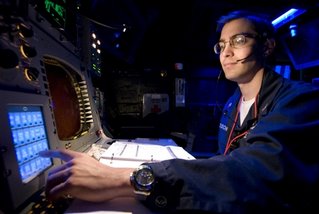
Posted by John Keller
The shootdown this week of a malfunctioning U.S. radar surveillance satellite, known as USA-193, has got to be one of the biggest Chicken-Little stories I've seen in a long time.
The picture I got from the mainstream press was of an out-of-control spacecraft filled with deadly poison careening toward world population centers to create a disaster of epic proportions in just days or even hours. It was right out of a Marvel comic book.
So the U.S. Navy stepped in and proposed to shoot the rogue satellite down with a ship-based SM-3 missile, originally designed to shatter the warheads of incoming intercontinental ballistic missiles. That ought to take care of the problem.
But you CAN'T, the press wailed. If you shoot it down you'll create an orbiting cloud of poison and lethal metal shrapnel that's the size of Texas ... or Alaska ... or, well, that will be really big! What would happen if that came down on downtown Toledo?
Well, maybe we shouldn't shoot it down, the Pentagon suggested. But you HAVE to shoot it down, the press cried. What if that satellite's fuel tank of poison hydrazine actually hit the Earth intact? Imagine the fatalities!
All right, already, the Navy sighed. We'll shoot it down. Just relax! Well, just do it so ... nothing bad happens, the press nagged, offering to repeat in gory detail the long lists of potential disasters from shooting it down -- or not shooting it down -- that had been churned out for days and days.
So the Navy shot it down Wednesday night. We're saved ... unless anyone gets hit by a piece of satellite or gets a whiff of hydrazine. If that happens there'll be Hell to pay. Let's keep our fingers crossed.
All during these bouts of public weeping and gnashing of teeth, I wondered what the big deal was. Let's look at the options.
First, what if we did nothing? Well, the satellite would probably burn up on re-entering the Earth's atmosphere, with a few residual small pieces falling in the ocean or in some farmer's field. The hydrazine fuel would ignite in the atmosphere, with little likelihood that any would make it to the ground.
Space junk does fall out of the sky from time to time, you know. On a visit to the Air Force Space Command in Los Angeles a few years ago, I noticed several blackened chunks of metal mounted on pedestals on display. I asked what they were, and they turned out to be space junk that fell out of orbit and landed on the ground as they were. Some were pretty big, too.
I never heard about even one of those rogue space chunks when they fell out of the sky. Funny how that could happen.
Okay, what about the second option of shooting the satellite down? A satellite is slower and more predictable than an incoming ICBM warhead, so this most likely would be a pretty easy shot for the Navy's SM-3 missiles tipped with the Lightweight Exo-Atmospheric Projectile (LEAP).
Let's see now, that rogue satellite was traveling at about 17,000 miles per hour. The SM-3, once it gets moving, goes about 6,000 miles an hour. Even at an oblique angle, think of the closing speed. I've seen some pretty hairy car crashes out on Route 128 near Boston, where there wasn't much left. Those cars were probably going about 60 miles an hour, give or take.
I really don't think there was much left of the satellite after that LEAP-tipped SM-3 got through with it. I had to laugh when people wondered if the missile would break the satellite's fuel tank.
So what did we achieve by shooting down that satellite? Much, actually, and none of it had anything whatsoever to do with averting a disaster.
Remember when the Chinese used a missile to shoot down one of their own satellites about a year ago? I think shooting down USA-193 was just a nice way to let the Chinese know that we can do it, too. We'd probably also be pretty good at shooting down incoming ICBMs. Everyone see that?
So there it is. But I guess it was a pretty fun ride while it lasted. I think it's safe to say, however, that if the U.S. and China ever get in a shooting war, that a lot of satellites are going to come down real fast. That's the other lesson of USA-193.
The photo above is of U.S. Navy Petty Officer 2nd Class Andrew Jackson as he activates a modified tactical SM-3 missile from the guided missile cruiser USS Lake Erie last Wednesday. The accompanying video is the shootdown of a malfunctioning satellite.

Posted by John Keller
The shootdown this week of a malfunctioning U.S. radar surveillance satellite, known as USA-193, has got to be one of the biggest Chicken-Little stories I've seen in a long time.
The picture I got from the mainstream press was of an out-of-control spacecraft filled with deadly poison careening toward world population centers to create a disaster of epic proportions in just days or even hours. It was right out of a Marvel comic book.
So the U.S. Navy stepped in and proposed to shoot the rogue satellite down with a ship-based SM-3 missile, originally designed to shatter the warheads of incoming intercontinental ballistic missiles. That ought to take care of the problem.
But you CAN'T, the press wailed. If you shoot it down you'll create an orbiting cloud of poison and lethal metal shrapnel that's the size of Texas ... or Alaska ... or, well, that will be really big! What would happen if that came down on downtown Toledo?
Well, maybe we shouldn't shoot it down, the Pentagon suggested. But you HAVE to shoot it down, the press cried. What if that satellite's fuel tank of poison hydrazine actually hit the Earth intact? Imagine the fatalities!
All right, already, the Navy sighed. We'll shoot it down. Just relax! Well, just do it so ... nothing bad happens, the press nagged, offering to repeat in gory detail the long lists of potential disasters from shooting it down -- or not shooting it down -- that had been churned out for days and days.
So the Navy shot it down Wednesday night. We're saved ... unless anyone gets hit by a piece of satellite or gets a whiff of hydrazine. If that happens there'll be Hell to pay. Let's keep our fingers crossed.
All during these bouts of public weeping and gnashing of teeth, I wondered what the big deal was. Let's look at the options.
First, what if we did nothing? Well, the satellite would probably burn up on re-entering the Earth's atmosphere, with a few residual small pieces falling in the ocean or in some farmer's field. The hydrazine fuel would ignite in the atmosphere, with little likelihood that any would make it to the ground.
Space junk does fall out of the sky from time to time, you know. On a visit to the Air Force Space Command in Los Angeles a few years ago, I noticed several blackened chunks of metal mounted on pedestals on display. I asked what they were, and they turned out to be space junk that fell out of orbit and landed on the ground as they were. Some were pretty big, too.
I never heard about even one of those rogue space chunks when they fell out of the sky. Funny how that could happen.
Okay, what about the second option of shooting the satellite down? A satellite is slower and more predictable than an incoming ICBM warhead, so this most likely would be a pretty easy shot for the Navy's SM-3 missiles tipped with the Lightweight Exo-Atmospheric Projectile (LEAP).
Let's see now, that rogue satellite was traveling at about 17,000 miles per hour. The SM-3, once it gets moving, goes about 6,000 miles an hour. Even at an oblique angle, think of the closing speed. I've seen some pretty hairy car crashes out on Route 128 near Boston, where there wasn't much left. Those cars were probably going about 60 miles an hour, give or take.
I really don't think there was much left of the satellite after that LEAP-tipped SM-3 got through with it. I had to laugh when people wondered if the missile would break the satellite's fuel tank.
So what did we achieve by shooting down that satellite? Much, actually, and none of it had anything whatsoever to do with averting a disaster.
Remember when the Chinese used a missile to shoot down one of their own satellites about a year ago? I think shooting down USA-193 was just a nice way to let the Chinese know that we can do it, too. We'd probably also be pretty good at shooting down incoming ICBMs. Everyone see that?
So there it is. But I guess it was a pretty fun ride while it lasted. I think it's safe to say, however, that if the U.S. and China ever get in a shooting war, that a lot of satellites are going to come down real fast. That's the other lesson of USA-193.
The photo above is of U.S. Navy Petty Officer 2nd Class Andrew Jackson as he activates a modified tactical SM-3 missile from the guided missile cruiser USS Lake Erie last Wednesday. The accompanying video is the shootdown of a malfunctioning satellite.
Tuesday, February 19, 2008
Indian Ocean becoming a hotbed of sophisticated submarine activity
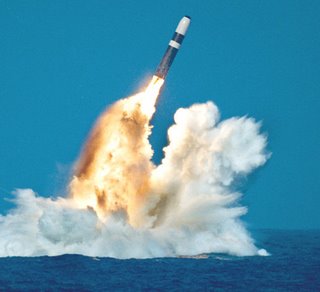
Posted by John Keller
Submarines are back in the news today with word that India is developing a nuclear-capable missile that can be launched from a submerged submarine.
I don't know what this exactly means for the regional balance of power in and around the Indian Ocean, but Pakistan -- a sworn and nuclear-armed enemy of India -- reportedly is alarmed at these developments.
The missile that India plans to integrate into a missile submarine it has under construction, the K-15, reportedly has a top range of 438 miles, which would put a growing number of areas in and around the Indian ocean within its range.
The story about India's nuclear submarine ambitions appeared today in Spacewar.com in a story entitled India to test submarine-based missile. A story confirming the upcoming tests appears in the Indian online publication newKerala.com. Writes Spacewar.com:
India has one of the most sophisticated submarine fleets in the region, with what experts believe are 12 to 15 undersea vessels. In addition, India has six diesel-electric submarines on order -- at least three of which are expected to have super-quiet air-independent propulsion (AIP) systems that render them as quiet as advanced U.S. nuclear attack submarines. Maybe even quieter.
India rival Pakistan, meanwhile, also has a sophisticated submarine fleet. That country has at least eight submarines, four diesel-electric French Daphne-class submarines purchased in the 1970s, two French Agosta-class diesel-electric submarines, and two advanced French Agosta 90B-type quiet diesel-electric submarines that could be improved even more with AIP.
Adding to the mix is South Africa on the western fringe of the Indian Ocean, which completed sea-acceptance trials for its third and last German-built Type 209/1400 Mod submarine, the SAS Queen Modjadji, off the coast of Kristiansand, southern Norway. These boats are equipped with an ISUS 90-45 sonar, command and weapon control system from Atlas Elektronik of Bremen, Germany, according to a story in Aviation Week's Ares blog entitled South Africa's Submarine Flottilla is Complete.
Iran also is developing its own submarine force, but is operating relatively old diesel-electric boats and its own home-built mini-subs, and does not yet appear to be a regional submarine threat. Yet, that is.
Add this to the Israeli navy’s purchase two summers ago of two more sophisticated attack submarines, which experts say are capable of firing nuclear-tipped cruise missiles that can hit targets in Iran, and you have potent submarine mix in the region.
I'm hoping the U.S. Navy is taking these developments into consideration as its leaders plan for the next generation of anti-submarine warfare technology.
The accompanying photo is of a U.S. Trident ballistic missile launched from a U.S. Navy Ohio-class ballistic missile submarine.

Posted by John Keller
Submarines are back in the news today with word that India is developing a nuclear-capable missile that can be launched from a submerged submarine.
I don't know what this exactly means for the regional balance of power in and around the Indian Ocean, but Pakistan -- a sworn and nuclear-armed enemy of India -- reportedly is alarmed at these developments.
The missile that India plans to integrate into a missile submarine it has under construction, the K-15, reportedly has a top range of 438 miles, which would put a growing number of areas in and around the Indian ocean within its range.
The story about India's nuclear submarine ambitions appeared today in Spacewar.com in a story entitled India to test submarine-based missile. A story confirming the upcoming tests appears in the Indian online publication newKerala.com. Writes Spacewar.com:
If the test is successful, India will be capable of launching missiles from air, land, ships and submarines, and it will join an elite group that includes the United States, Russia, France and China, experts said. The announcement comes two months after India's chief military scientist M. Natarajan said that New Delhi would test a ballistic missile with a range of 6,000 kilometres (3,800 miles) in 2008. [S. Prahlada, chief controller of India's Defence Research and Development Organisation (DRDO)] said the K-15 missile, following its experimental launch, will be "integrated" with a nuclear-powered submarine that India is building. He also said DRDO scientists would carry out another test of the 4,000-kilometre (2,480 miles) range Agni-III ballistic missile, which could hit targets deep inside China.
India has one of the most sophisticated submarine fleets in the region, with what experts believe are 12 to 15 undersea vessels. In addition, India has six diesel-electric submarines on order -- at least three of which are expected to have super-quiet air-independent propulsion (AIP) systems that render them as quiet as advanced U.S. nuclear attack submarines. Maybe even quieter.
India rival Pakistan, meanwhile, also has a sophisticated submarine fleet. That country has at least eight submarines, four diesel-electric French Daphne-class submarines purchased in the 1970s, two French Agosta-class diesel-electric submarines, and two advanced French Agosta 90B-type quiet diesel-electric submarines that could be improved even more with AIP.
Adding to the mix is South Africa on the western fringe of the Indian Ocean, which completed sea-acceptance trials for its third and last German-built Type 209/1400 Mod submarine, the SAS Queen Modjadji, off the coast of Kristiansand, southern Norway. These boats are equipped with an ISUS 90-45 sonar, command and weapon control system from Atlas Elektronik of Bremen, Germany, according to a story in Aviation Week's Ares blog entitled South Africa's Submarine Flottilla is Complete.
Iran also is developing its own submarine force, but is operating relatively old diesel-electric boats and its own home-built mini-subs, and does not yet appear to be a regional submarine threat. Yet, that is.
Add this to the Israeli navy’s purchase two summers ago of two more sophisticated attack submarines, which experts say are capable of firing nuclear-tipped cruise missiles that can hit targets in Iran, and you have potent submarine mix in the region.
I'm hoping the U.S. Navy is taking these developments into consideration as its leaders plan for the next generation of anti-submarine warfare technology.
The accompanying photo is of a U.S. Trident ballistic missile launched from a U.S. Navy Ohio-class ballistic missile submarine.
Sunday, February 17, 2008
Experiment demonstrates beam orders of magnitude more powerful than the Airborne Laser

Posted by John Keller
Here's an eye-opener for a Sunday morning. Researchers at the University of Michigan demonstrated a 300-terawatt pulsed laser beam that lasts 30 femtoseconds.
That beam duration isn't long -- just 30 millionths of a billionth of a second -- but I have to wonder what this might mean for laser weapons. Compare this power with the Airborne Laser (ABL), which is designed to shoot down intercontinental ballistic missiles from the platform of a Boeing 747 jetliner.
The ABL is a "megawatt-class" laser, or power in the millions of Watts. This laser, I believe, can last longer than 30 femtoseconds; it takes a little longer than that to destroy a ballistic missile in flight, but consider the difference in power. The one at University of Michigan is terawatt-class.
"If you could hold a giant magnifying glass in space and focus all the sunlight shining toward Earth onto one grain of sand, that concentrated ray would approach the intensity of a new laser beam made in a University of Michigan laboratory," according to a story in PhysOrg.com entitled Michigan laser beam believed to set record for intensity. "'That's the instantaneous intensity we can produce,' said Karl Krushelnick, a physics and engineering professor. 'I don't know of another place in the universe that would have this intensity of light. We believe this is a record.'" Explains PhysOrg.com:
The university researchers envision putting this kind of laser to work in applications like proton and electron beams for radiation treatment of cancer, but I'm thinking about what kind of potential it holds for laser weapons. If there's anyone out there who has a good idea, please let me know in a comment below.
Harnessing this kind of power has to have the scientists at DARPA thinking. A detailed white paper about the experiment is online in .pdf format if you'd like to do a deep dive. I realize that the University of Michigan laser, an upgrade of the Hercules laser, is the size of several rooms, but the computer chip in your PC was once that size, too.
The accompanying photo shows the amplifier for the Hercules laser as it fires. The photo is by Anatoly Maksimchuk, associate research scientist in the Department of Electrical Engineering and Computer Science at University of Michigan in Ann Arbor, Mich.

Posted by John Keller
Here's an eye-opener for a Sunday morning. Researchers at the University of Michigan demonstrated a 300-terawatt pulsed laser beam that lasts 30 femtoseconds.
That beam duration isn't long -- just 30 millionths of a billionth of a second -- but I have to wonder what this might mean for laser weapons. Compare this power with the Airborne Laser (ABL), which is designed to shoot down intercontinental ballistic missiles from the platform of a Boeing 747 jetliner.
The ABL is a "megawatt-class" laser, or power in the millions of Watts. This laser, I believe, can last longer than 30 femtoseconds; it takes a little longer than that to destroy a ballistic missile in flight, but consider the difference in power. The one at University of Michigan is terawatt-class.
"If you could hold a giant magnifying glass in space and focus all the sunlight shining toward Earth onto one grain of sand, that concentrated ray would approach the intensity of a new laser beam made in a University of Michigan laboratory," according to a story in PhysOrg.com entitled Michigan laser beam believed to set record for intensity. "'That's the instantaneous intensity we can produce,' said Karl Krushelnick, a physics and engineering professor. 'I don't know of another place in the universe that would have this intensity of light. We believe this is a record.'" Explains PhysOrg.com:
The record-setting beam measures 20 billion trillion Watts per square centimeter. It contains 300 terawatts of power. That's 300 times the capacity of the entire U.S. electricity grid. The laser beam's power is concentrated to a 1.3-micron speck about 100th the diameter of a human hair. A human hair is about 100 microns wide. This intensity is about two orders of magnitude higher than any other laser in the world can produce, said Victor Yanovsky, a research scientist in the U-M Department of Electrical Engineering and Computer Science who built the ultra-high power system over the past six years. The laser can produce this intense beam once every 10 seconds, whereas other powerful lasers can take an hour to recharge.
The university researchers envision putting this kind of laser to work in applications like proton and electron beams for radiation treatment of cancer, but I'm thinking about what kind of potential it holds for laser weapons. If there's anyone out there who has a good idea, please let me know in a comment below.
Harnessing this kind of power has to have the scientists at DARPA thinking. A detailed white paper about the experiment is online in .pdf format if you'd like to do a deep dive. I realize that the University of Michigan laser, an upgrade of the Hercules laser, is the size of several rooms, but the computer chip in your PC was once that size, too.
The accompanying photo shows the amplifier for the Hercules laser as it fires. The photo is by Anatoly Maksimchuk, associate research scientist in the Department of Electrical Engineering and Computer Science at University of Michigan in Ann Arbor, Mich.
Friday, February 15, 2008
Market outlook positive among exhibitors at Components for Military and Space Electronics conference
Posted by John McHale
Despite shrinking research and development (R & D) funding within the Department of Defense Budget and uncertainty about who will take over as commander-in-chief in 2009, high-reliability component vendors are very optimistic about the future.
Ken O'Neil, director of military and aerospace marketing for Actel in Sunnyvale, says last year was very profitable for his company and he expects even better results in 2008.
Doug Patterson, vice president of sales and marketing, at AiTech also sees many opportunities in the defense and space market, especially with more platforms coming in for retrofits.
Some attendees mentioned how they were pleasantly surprised that the lower R & D budget is not having a more negative impact on their sales forecasts. They say they feel the depleted munitions stores and other supplies that use high-reliability electronics will take years to build-up, which means more opportunities for component vendors.
A lower R & D budget in the past has also affected our magazine, since it typically means fewer opportunities for our advertisers. Maybe R & D dollars are not the mitigating factor in our market that they once were.
Even if the overall budget shrinks, defense leaders will still rely heavily on technology - technology that is enabled by high-performance electronics - for surveillance and reconnaissance in times of peace as well as in the building of stockpiles.
In the meantime, these same leaders are shelving funding for long-term programs and projects in favor of technology they can field and put in the warfighter's hands today.
I'm reminded of what a prime contractor executive told me a little over a year ago in response to a question on shrinking R & D dollars. He said that despite the smaller overall budget, funding for technology for C4ISR (command, control, communications, computers, intelligence, surveillance, and reconnaissance) technology is going up and will continue to do so.
C4ISR programs need high performance electronics for unmanned systems, which many market analysts see growing to more than a $30 billion market over the next 10 years.
All of this does sound pretty good. What is your opinion? Is the market trending up? Will a democrat in the Oval Office hurt the defense electronics market?
Tell us what you think.
Despite shrinking research and development (R & D) funding within the Department of Defense Budget and uncertainty about who will take over as commander-in-chief in 2009, high-reliability component vendors are very optimistic about the future.
Ken O'Neil, director of military and aerospace marketing for Actel in Sunnyvale, says last year was very profitable for his company and he expects even better results in 2008.
Doug Patterson, vice president of sales and marketing, at AiTech also sees many opportunities in the defense and space market, especially with more platforms coming in for retrofits.
Some attendees mentioned how they were pleasantly surprised that the lower R & D budget is not having a more negative impact on their sales forecasts. They say they feel the depleted munitions stores and other supplies that use high-reliability electronics will take years to build-up, which means more opportunities for component vendors.
A lower R & D budget in the past has also affected our magazine, since it typically means fewer opportunities for our advertisers. Maybe R & D dollars are not the mitigating factor in our market that they once were.
Even if the overall budget shrinks, defense leaders will still rely heavily on technology - technology that is enabled by high-performance electronics - for surveillance and reconnaissance in times of peace as well as in the building of stockpiles.
In the meantime, these same leaders are shelving funding for long-term programs and projects in favor of technology they can field and put in the warfighter's hands today.
I'm reminded of what a prime contractor executive told me a little over a year ago in response to a question on shrinking R & D dollars. He said that despite the smaller overall budget, funding for technology for C4ISR (command, control, communications, computers, intelligence, surveillance, and reconnaissance) technology is going up and will continue to do so.
C4ISR programs need high performance electronics for unmanned systems, which many market analysts see growing to more than a $30 billion market over the next 10 years.
All of this does sound pretty good. What is your opinion? Is the market trending up? Will a democrat in the Oval Office hurt the defense electronics market?
Tell us what you think.
Wednesday, February 13, 2008
2009 DOD budget: a safe plan in the president's last year
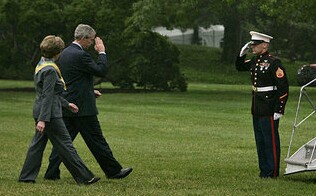
Posted by John Keller
The U.S. Department of Defense (DOD) has released its budget request for next year, fiscal 2009, and it looks to be a safe budget for President Bush's last year in office. We'll have a new president by the time the next DOD budget request comes out, Bush looks like he has left any hard decisions up to the next chief executive.
There's not a lot that stands out in the DOD's latest budget. Generally it would keep the money faucets turned on at stable levels across the board. Nothing major seems to be cut, and nothing major seems to have a substantial increase.
In other words, steady as she goes. Let the next commander-in-chief make the tough choices.
There could have been big changes, but that wasn't likely in an election year. The Joint Strike Fighter program continues on course, even though some experts point out that this multi-billion-dollar program would make a juicy target for reducing spending.
Other programs that have received close scrutiny and much criticism in recent months -- the Transformational Satellite Communications System (TSAT), the Navy's Littoral Combat Ship, the Joint Tactical Radio System, and ballistic missile defense -- all would receive predictable funding levels in this budget.
Just as this budget request contains few, if any, surprises, I'll bet we'll see more of the same routine on Capitol Hill this spring as Congress discusses whether to grant the Pentagon's proposed spending. It's an election year, after all, and no one wants to be singled out as a big enemy of defense spending.
If big cuts are going to happen, we might see them next year or the year after. For now, it's status quo.
It's shaping up that it doesn't matter if members of Congress are Democrats, Republicans, liberals, or conservatives. No one seems very interested in cutting defense spending in a substantial way. I predicted that the 2008 defense budget would face tough sledding in Congress this past year, but I was wrong. Lawmakers approved the budget essentially as submitted with little fanfare.
I think we'll see the same in coming years. Members of Congress don't want to be seen as anti-military, and the next president won't, either. If the next president is John McCain, he's making the war on terror the centerpiece of his campaign, so spending would seem safe with him.
If the next president is Barack Obama or Hillary Clinton, that person will be under intense pressure to appear tough in international relations. Military spending would appear safe there, too.
I don't think there is a lot to worry about if you're involved in the defense business. Some experts even predict that defense spending could help prop up the economy as the retail and housing sectors soften. We'll see how things unfold.

Posted by John Keller
The U.S. Department of Defense (DOD) has released its budget request for next year, fiscal 2009, and it looks to be a safe budget for President Bush's last year in office. We'll have a new president by the time the next DOD budget request comes out, Bush looks like he has left any hard decisions up to the next chief executive.
There's not a lot that stands out in the DOD's latest budget. Generally it would keep the money faucets turned on at stable levels across the board. Nothing major seems to be cut, and nothing major seems to have a substantial increase.
In other words, steady as she goes. Let the next commander-in-chief make the tough choices.
There could have been big changes, but that wasn't likely in an election year. The Joint Strike Fighter program continues on course, even though some experts point out that this multi-billion-dollar program would make a juicy target for reducing spending.
Other programs that have received close scrutiny and much criticism in recent months -- the Transformational Satellite Communications System (TSAT), the Navy's Littoral Combat Ship, the Joint Tactical Radio System, and ballistic missile defense -- all would receive predictable funding levels in this budget.
Just as this budget request contains few, if any, surprises, I'll bet we'll see more of the same routine on Capitol Hill this spring as Congress discusses whether to grant the Pentagon's proposed spending. It's an election year, after all, and no one wants to be singled out as a big enemy of defense spending.
If big cuts are going to happen, we might see them next year or the year after. For now, it's status quo.
It's shaping up that it doesn't matter if members of Congress are Democrats, Republicans, liberals, or conservatives. No one seems very interested in cutting defense spending in a substantial way. I predicted that the 2008 defense budget would face tough sledding in Congress this past year, but I was wrong. Lawmakers approved the budget essentially as submitted with little fanfare.
I think we'll see the same in coming years. Members of Congress don't want to be seen as anti-military, and the next president won't, either. If the next president is John McCain, he's making the war on terror the centerpiece of his campaign, so spending would seem safe with him.
If the next president is Barack Obama or Hillary Clinton, that person will be under intense pressure to appear tough in international relations. Military spending would appear safe there, too.
I don't think there is a lot to worry about if you're involved in the defense business. Some experts even predict that defense spending could help prop up the economy as the retail and housing sectors soften. We'll see how things unfold.
Tuesday, February 12, 2008
Real heroes: take a moment today to remember Abraham Lincoln

Posted by John Keller
Today is Abraham Lincoln's birthday, which tragically seems to have fallen out of style. When I was a kid, everyone got the day off -- Feb. 12. Now his birthday has been homogenized into presidents day, a time for car dealer sales during the winter doldrums.
I don't take Lincoln's birthday off anymore, but I still celebrate it. We are who we are largely because of him.
Before Lincoln, we said "the United States are ..." After Lincoln we say "the United States is ..." Before Lincoln we were a collection of states. He gave the word Union real, even sacred meaning. Now we're one country. Some people would like to think that we're still just a collection of languages, races, genders, liberals, conservatives, and whatever else, but we're clearly one country now, and it's because of Abraham Lincoln.
He wouldn't quit, even though many people wanted him to -- including one man who for a time commanded all of the U.S. Army during the fight for Union in the Civil War. Lincoln was tortured with mayhem, blood, and fratricide on an unimaginable scale for four years, all because it was his solemn conviction that the United States was too precious to let be destroyed.
Few people could make a point like Lincoln. Most of us when we remember him think of the Gettysburg Address -- that marvelous nugget of brevity that so clearly captures the quintessential American Struggle.
Believe it or not, however, The Gettysburg Address is not my favorite piece by Lincoln. My favorite is the so-called "Widow Bixby Letter," which just as clearly lays out the depth of human struggle that Lincoln and many, many other Americans endured to help make us what we are today.
On that note, I'll leave you with Lincoln's words in the Widow Bixby letter, which was published in the Boston Transcript on 25 Nov. 1864 -- the same day Mrs. Bixby received it:

Posted by John Keller
Today is Abraham Lincoln's birthday, which tragically seems to have fallen out of style. When I was a kid, everyone got the day off -- Feb. 12. Now his birthday has been homogenized into presidents day, a time for car dealer sales during the winter doldrums.
I don't take Lincoln's birthday off anymore, but I still celebrate it. We are who we are largely because of him.
Before Lincoln, we said "the United States are ..." After Lincoln we say "the United States is ..." Before Lincoln we were a collection of states. He gave the word Union real, even sacred meaning. Now we're one country. Some people would like to think that we're still just a collection of languages, races, genders, liberals, conservatives, and whatever else, but we're clearly one country now, and it's because of Abraham Lincoln.
He wouldn't quit, even though many people wanted him to -- including one man who for a time commanded all of the U.S. Army during the fight for Union in the Civil War. Lincoln was tortured with mayhem, blood, and fratricide on an unimaginable scale for four years, all because it was his solemn conviction that the United States was too precious to let be destroyed.
Few people could make a point like Lincoln. Most of us when we remember him think of the Gettysburg Address -- that marvelous nugget of brevity that so clearly captures the quintessential American Struggle.
Believe it or not, however, The Gettysburg Address is not my favorite piece by Lincoln. My favorite is the so-called "Widow Bixby Letter," which just as clearly lays out the depth of human struggle that Lincoln and many, many other Americans endured to help make us what we are today.
On that note, I'll leave you with Lincoln's words in the Widow Bixby letter, which was published in the Boston Transcript on 25 Nov. 1864 -- the same day Mrs. Bixby received it:
Dear Madam,
I have been shown in the files of the War Department a statement of the Adjutant General of Massachusetts, that you are the mother of five sons who have died gloriously on the field of battle.
I feel how weak and fruitless must be any words of mine which should attempt to beguile you from the grief of a loss so overwhelming. But I cannot refrain from tendering to you the consolation that may be found in the thanks of the Republic they died to save.
I pray that our Heavenly Father may assuage the anguish of your bereavement, and leave you only the cherished memory of the loved and lost, and the solemn pride that must be yours, to have laid so costly a sacrifice upon the altar of Freedom.
Yours, very sincerely and respectfully,
A. Lincoln
Monday, February 11, 2008
Real intelligence, or artificial intelligence; you be the judge

Posted by John Keller
Maybe it's me, but sometimes I just feel more comfortable knowing there's real intelligence, rather than artificial intelligence, standing between me and a potentially fiery death.
Yeah, I know, I'm just a nervous Nellie, but I gotta admit that a story in Network World entitled DARPA advances artificial intelligence program for air traffic control gives me pause. Don't get me wrong, I think artificial intelligence is great, but I've just seen too much of it to trust it with my life.
There, I said it. You can condemn me as a Luddite now.
But just be advised that back in the mid-'80s I used to edit a technology newsletter called Advanced Military Computing, which used to cover artificial intelligence (AI) projects at DARPA pretty closely. I remember the Autonomous Land Vehicle, as well as Pilot's Associate. Those programs yielded great technology, but -- to put it mildly -- there were a few bumps along the way.
The Autonomous Land Vehicle's machine vision system used to mistake shadows for big potholes and other obstructions. I remember a joke about a rule-based expert system designed to diagnose problems with cars. You'd tell the computer that the car was six years old and had red flecks on its body. Answer: the car has the measles.
Maybe I'm just being silly. That's 20 years ago, and artificial intelligence has had two more decades of research and development. It's gotta be a lot better, right?
According to Network World, DARPA is using the Generalized Integrated Learning Architecture (GILA) system, developed by Lockheed Martin's Advanced Technology Laboratories. GILA is intended to help the Air Force keep airspace operating safely with increasing numbers of manned aircraft, unmanned aerial vehicles (UAVs) and even airborne weapons.
Airborne weapons? Yikes! I'll remember that the next time I can read the tail numbers on that eastbound US Airways 727 somewhere over Kansas as I'm heading to the West Coast. I'll thank my lucky stars it was a passenger jet and not a cruise missile.
Is anyone else nervous out there?
DARPA and Lockheed Martin say the GILA system can actually learn flight controllers' tasks -- sometimes using just one example. C'mon, can't we build in some review time for that system? If I had to learn with just one example I'd never have made it out of elementary school. Reports Network World:
Jeez, I WROTE that Military & Aerospace item. I didn't think they'd use it for air traffic control! I've got a what-if question: what if the computer learns the wrong stuff?
I can't help thinking of that old joke about the fully automated aircraft. There's a recording to reassure passengers that goes something like this: "Welcome to the first fully automated passenger aircraft. There is no pilot on board. Everything's taken care of by the world's most advanced and sophisticated computers. We have taken great care to ensure that nothing will ever go wrong ... go wrong ... go wrong ... go wrong ...
You'll have to excuse me now. I've got a plane to catch.

Posted by John Keller
Maybe it's me, but sometimes I just feel more comfortable knowing there's real intelligence, rather than artificial intelligence, standing between me and a potentially fiery death.
Yeah, I know, I'm just a nervous Nellie, but I gotta admit that a story in Network World entitled DARPA advances artificial intelligence program for air traffic control gives me pause. Don't get me wrong, I think artificial intelligence is great, but I've just seen too much of it to trust it with my life.
There, I said it. You can condemn me as a Luddite now.
But just be advised that back in the mid-'80s I used to edit a technology newsletter called Advanced Military Computing, which used to cover artificial intelligence (AI) projects at DARPA pretty closely. I remember the Autonomous Land Vehicle, as well as Pilot's Associate. Those programs yielded great technology, but -- to put it mildly -- there were a few bumps along the way.
The Autonomous Land Vehicle's machine vision system used to mistake shadows for big potholes and other obstructions. I remember a joke about a rule-based expert system designed to diagnose problems with cars. You'd tell the computer that the car was six years old and had red flecks on its body. Answer: the car has the measles.
Maybe I'm just being silly. That's 20 years ago, and artificial intelligence has had two more decades of research and development. It's gotta be a lot better, right?
According to Network World, DARPA is using the Generalized Integrated Learning Architecture (GILA) system, developed by Lockheed Martin's Advanced Technology Laboratories. GILA is intended to help the Air Force keep airspace operating safely with increasing numbers of manned aircraft, unmanned aerial vehicles (UAVs) and even airborne weapons.
Airborne weapons? Yikes! I'll remember that the next time I can read the tail numbers on that eastbound US Airways 727 somewhere over Kansas as I'm heading to the West Coast. I'll thank my lucky stars it was a passenger jet and not a cruise missile.
Is anyone else nervous out there?
DARPA and Lockheed Martin say the GILA system can actually learn flight controllers' tasks -- sometimes using just one example. C'mon, can't we build in some review time for that system? If I had to learn with just one example I'd never have made it out of elementary school. Reports Network World:
DARPA says the artificial intelligence software will learn by assembling knowledge from different sources-including generating knowledge by reasoning. According to a Military & Aerospace item, such software has to combine limited observations with subject expertise, general knowledge, reasoning, and by asking what-if questions.
Jeez, I WROTE that Military & Aerospace item. I didn't think they'd use it for air traffic control! I've got a what-if question: what if the computer learns the wrong stuff?
I can't help thinking of that old joke about the fully automated aircraft. There's a recording to reassure passengers that goes something like this: "Welcome to the first fully automated passenger aircraft. There is no pilot on board. Everything's taken care of by the world's most advanced and sophisticated computers. We have taken great care to ensure that nothing will ever go wrong ... go wrong ... go wrong ... go wrong ...
You'll have to excuse me now. I've got a plane to catch.
Sunday, February 10, 2008
Infrared-obscuring smoke: let the electro-optical wars begin

Posted by John Keller
Military technology never seems to last long in a vacuum. When one breakthrough system is developed, something able to counter its capabilities usually follows closely behind.
We can see this phenomenon from ancient times. The invention of the stirrup -- every bit as significant as the machine gun and the atom bomb -- enabled soldiers to fight fast and hit hard from horseback. It wasn't long, however, until infantry learned to form squares with spears protruding outward to repel cavalry charges.
The machine gun led to trenches and other concealment. Heat-seeking and radar-guided missiles? Enter flares and chaff dispensers to confuse the missiles' guidance systems. To counter visible-light sensors like cameras and the naked eye, soldiers for centuries have thrown up smoke screens, often with great affect.
Smoke has met its match in recent years with the infrared sensor, which detects heat instead of reflected light. IR sensors are extremely effective at penetrating smoke, dust, and other obscurants. The problem is these sensors are progressively becoming less expensive and more widely available.
The Army has developed separate smoke-emitting weapons to fool visible-light and infrared sensors, but has no one weapon that can counter both. How to regain the edge?
Wired's Danger Room blog has a story entitled Army Looking for Infrared Smoke Screens that talks about efforts at the U.S. Army Aberdeen Proving Ground, Md., to develop a bi-spectral smoke/obscurant -- or one kind of smoke screen to hide soldiers from visible-light and infrared sensors.
The Army has issued a Small Business Technology Transfer (STTR) solicitation open from 19 Feb. to 19 March for companies to solicit ideas on developing bi-spectral smoke/obscurant material. "This material will form an obscuring screen for the protection of soldiers and platforms against visible and infrared threats (heat seeking missiles, thermal viewer, laser guided missiles, sniper fire, etc.)," the solicitation states.
Intensive chemistry and material science, breakthroughs in vapor phase synthesis, and nanotechnology may be involved in this new bi-spectral obscurant, Army researchers say.
Now let's see what's eventually developed to counter this new weapon.

Posted by John Keller
Military technology never seems to last long in a vacuum. When one breakthrough system is developed, something able to counter its capabilities usually follows closely behind.
We can see this phenomenon from ancient times. The invention of the stirrup -- every bit as significant as the machine gun and the atom bomb -- enabled soldiers to fight fast and hit hard from horseback. It wasn't long, however, until infantry learned to form squares with spears protruding outward to repel cavalry charges.
The machine gun led to trenches and other concealment. Heat-seeking and radar-guided missiles? Enter flares and chaff dispensers to confuse the missiles' guidance systems. To counter visible-light sensors like cameras and the naked eye, soldiers for centuries have thrown up smoke screens, often with great affect.
Smoke has met its match in recent years with the infrared sensor, which detects heat instead of reflected light. IR sensors are extremely effective at penetrating smoke, dust, and other obscurants. The problem is these sensors are progressively becoming less expensive and more widely available.
The Army has developed separate smoke-emitting weapons to fool visible-light and infrared sensors, but has no one weapon that can counter both. How to regain the edge?
Wired's Danger Room blog has a story entitled Army Looking for Infrared Smoke Screens that talks about efforts at the U.S. Army Aberdeen Proving Ground, Md., to develop a bi-spectral smoke/obscurant -- or one kind of smoke screen to hide soldiers from visible-light and infrared sensors.
The Army has issued a Small Business Technology Transfer (STTR) solicitation open from 19 Feb. to 19 March for companies to solicit ideas on developing bi-spectral smoke/obscurant material. "This material will form an obscuring screen for the protection of soldiers and platforms against visible and infrared threats (heat seeking missiles, thermal viewer, laser guided missiles, sniper fire, etc.)," the solicitation states.
Intensive chemistry and material science, breakthroughs in vapor phase synthesis, and nanotechnology may be involved in this new bi-spectral obscurant, Army researchers say.
Now let's see what's eventually developed to counter this new weapon.
Friday, February 8, 2008
Power-efficient chips and body heat may combine to make some battery applications obsolete

Posted by John Keller
There's potentially good news this week for every soldier who's ever had to take the field burdened by pounds and pounds of batteries to keep his
-- radio
-- GPS navigator
-- rugged PDA
-- night-vision goggles
-- rugged laptop
-- wearable displays
-- fill in may, many more blanks
powered up for the mission at hand. Yeah, I know, soldiers always have shouldered heavy loads since the dawn of human history. It's worse these days, though, especially with the growing number of batteries these folks have to bring along. Couple that with 120-degree heat in the Middle East and you've got some wilted infantrymen.
Take a look at the photo above left of an exhausted U.S soldier in a bunker in Afghanistan. This photo, by Britain's Tim Hetherington for Vanity Fair magazine, recently won the top World Press Photo prize for news photography. The soldier's expression shows how a lot of our soldiers feel when they take the field day-in and day-out carrying heavy loads.
That might change in the future, though, at least as far as the batteries necessary to power electronics and electro-optics in the field. Researchers at the Massachusetts Institute of Technology say they have designed an energy-efficient chip that can reduce power consumption by 10 times.
Computerworld reports in a story entitled MIT: Human body heat may someday power energy-efficient chip that chips this efficient might not even need batteries at all. They might be able to harvest all the power they need from the soldier's body heat.
MIT talked about the new super-efficient chips this past week at the International Solid State Circuits Conference in San Francisco.
Computerworld also says that Texas Instruments is very interested in the new chip design, and company officials say they might be able to start fielding body-heat-powered electronics with the new chips in as short a time as five years.
This may not be as far-fetched as it sounds. A North Carolina company called Nextreme Thermal Solutions has a way to package heat exchangers that are as small as 1 by 1 millimeter. The idea behind this Thermal Copper Pillar Bump technology is to cool chips, but Nextreme officials point out that the technology also can create small amounts of power from ambient heat.
Hmmmm ... enough power for the new MIT chips? Enough ambient heat from the human body to create this small amount of power?
I think we're on the verge of some very interesting things. I'm sure it's not soon enough for those overloaded soldiers in Iraq and Afghanistan.

Posted by John Keller
There's potentially good news this week for every soldier who's ever had to take the field burdened by pounds and pounds of batteries to keep his
-- radio
-- GPS navigator
-- rugged PDA
-- night-vision goggles
-- rugged laptop
-- wearable displays
-- fill in may, many more blanks
powered up for the mission at hand. Yeah, I know, soldiers always have shouldered heavy loads since the dawn of human history. It's worse these days, though, especially with the growing number of batteries these folks have to bring along. Couple that with 120-degree heat in the Middle East and you've got some wilted infantrymen.
Take a look at the photo above left of an exhausted U.S soldier in a bunker in Afghanistan. This photo, by Britain's Tim Hetherington for Vanity Fair magazine, recently won the top World Press Photo prize for news photography. The soldier's expression shows how a lot of our soldiers feel when they take the field day-in and day-out carrying heavy loads.
That might change in the future, though, at least as far as the batteries necessary to power electronics and electro-optics in the field. Researchers at the Massachusetts Institute of Technology say they have designed an energy-efficient chip that can reduce power consumption by 10 times.
Computerworld reports in a story entitled MIT: Human body heat may someday power energy-efficient chip that chips this efficient might not even need batteries at all. They might be able to harvest all the power they need from the soldier's body heat.
MIT talked about the new super-efficient chips this past week at the International Solid State Circuits Conference in San Francisco.
Computerworld also says that Texas Instruments is very interested in the new chip design, and company officials say they might be able to start fielding body-heat-powered electronics with the new chips in as short a time as five years.
This may not be as far-fetched as it sounds. A North Carolina company called Nextreme Thermal Solutions has a way to package heat exchangers that are as small as 1 by 1 millimeter. The idea behind this Thermal Copper Pillar Bump technology is to cool chips, but Nextreme officials point out that the technology also can create small amounts of power from ambient heat.
Hmmmm ... enough power for the new MIT chips? Enough ambient heat from the human body to create this small amount of power?
I think we're on the verge of some very interesting things. I'm sure it's not soon enough for those overloaded soldiers in Iraq and Afghanistan.
Tuesday, February 5, 2008
The future of network-centric surveillance
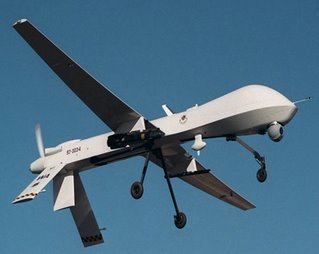
Posted by John Keller
I think we're seeing the future of network-centric surveillance in a U.S. Air Force project called Wide-Area Surveillance that seeks to blend information from many different imaging sensors into 3-D views of areas of interest.
This vision appears in a story in the Aviation Week and Space Technology blog entitled U.S. Air Force Eyes New Surveillance System that talks about Pentagon planning to develop an electro-optical intelligence system beginning sometime next year. Writes Av Week:
It is this stitching together of images from different sensors that is so intriguing. They re talking about several sensors on one aircraft, but what is to prevent smart systems designers from blending images from many sensors on different platforms -- manned and unmanned aircraft, orbiting satellites, surveillance balloons, combat vehicles, and even from gun sights on individual soldiers' weapons.
What might this kind of system yield? I can imagine the ability to mouse through a computer image and travel above, around, below, and inside areas of interest. This kind of imagery potentially could even add the dimension of time. Users could look around and inside areas of interest in real time, and then compare those images to the same images one hour, one day, or one week in the past.
Computer signal processing can do amazing things these days. The television weather man can give me his "futurecast" of storms many hours in the future. What if computers could extrapolate future events based on what has happened in the past? Might a multisensor system be able to shift us between the past, present, and future of surveillance areas of interest?
I know what you're probably thinking, because I saw that movie, too. Remember Deja Vu with Denzel Washington, which came out in 2006? It's a movie with the same kind of speculation, and you ought to take a look at it if you can suspend disbelief and can get through the car chases.
Still, this would be groundbreaking capability -- view from any angle from any time. This would be of immeasurable benefit, but only if we remember to trust what we can see with the naked eye.

Posted by John Keller
I think we're seeing the future of network-centric surveillance in a U.S. Air Force project called Wide-Area Surveillance that seeks to blend information from many different imaging sensors into 3-D views of areas of interest.
This vision appears in a story in the Aviation Week and Space Technology blog entitled U.S. Air Force Eyes New Surveillance System that talks about Pentagon planning to develop an electro-optical intelligence system beginning sometime next year. Writes Av Week:
Dubbed "wide area surveillance," the project stems from a prototype now operating in Iraq. The prototype system, built by the Air Force Research Laboratory and called Angel Fire, comprises multiple commercial cameras capable of collecting 1-2 frames per second. They are perched on a twin-engine, manned aircraft, which is being operated by contract personnel, the sources say. Images collected from the cameras can be "stitched" together using computers to present a near-360-degree vantage of a wide area. They may also be displayed in rapid succession to form a product similar to video.
It is this stitching together of images from different sensors that is so intriguing. They re talking about several sensors on one aircraft, but what is to prevent smart systems designers from blending images from many sensors on different platforms -- manned and unmanned aircraft, orbiting satellites, surveillance balloons, combat vehicles, and even from gun sights on individual soldiers' weapons.
What might this kind of system yield? I can imagine the ability to mouse through a computer image and travel above, around, below, and inside areas of interest. This kind of imagery potentially could even add the dimension of time. Users could look around and inside areas of interest in real time, and then compare those images to the same images one hour, one day, or one week in the past.
Computer signal processing can do amazing things these days. The television weather man can give me his "futurecast" of storms many hours in the future. What if computers could extrapolate future events based on what has happened in the past? Might a multisensor system be able to shift us between the past, present, and future of surveillance areas of interest?
I know what you're probably thinking, because I saw that movie, too. Remember Deja Vu with Denzel Washington, which came out in 2006? It's a movie with the same kind of speculation, and you ought to take a look at it if you can suspend disbelief and can get through the car chases.
Still, this would be groundbreaking capability -- view from any angle from any time. This would be of immeasurable benefit, but only if we remember to trust what we can see with the naked eye.
Friday, February 1, 2008
Laser-pitting technology may yield more opportunities for advanced camouflage
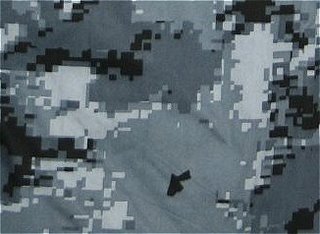
Posted by John Keller
A pair of researchers from the University of Rochester have come up with a way to use ultrashort laser bursts to make nearly imperceptible pockmarks in metal surfaces that can change the metal's color by altering how the it absorbs and reflects light.
Aw, so what, you might say. So jewelers might be able to change the gold color in a wedding ring to match the color of the bride or groom's eyes. Cute.
But that's not what I'm thinking. Imagine what this could do for the military in terms of camouflage, and for the costs of paint and corrosion protection. This technology has the potential to change the color of metal without paint.
Can you just feel the joy in the air as legions of Navy boatswain's mates ponder a future that may not include spending the better part of their lives painting ship hulls and fixtures?
Any kidding aside, now, think about what the Army spends every year on painting tanks and other armored combat vehicles, as well as sanding and scraping for rust and other deterioration. Combat vehicles with this technology might be able to be colored appropriately for the field without paint. Technicians could detect and repair rust and corrosion without scraping and repainting.
Yet what sounds most interesting is the potential for camouflage. A story this week in The New York Times entitled Lasers Make Other Metals Look Like Gold explains how this technique that uses femtosecond laser pulses can turn color metals orange, gold, blue, black, and other colors.
What's not clear, however, is with additional research might this technique be able to render metal invisible to different kinds of sensors? If it can change how metal absorbs and reflects light, then isn't it possible that no light could be reflected? How about confusing colors? It sounds like there's a lot of potential here.
The U.S. military has been putting time and resources into new kinds of camouflage for years. Look at the soldiers next time as you pass through the airport. Their battle dress uniforms have camouflage patterns like pixels on a computer screen. DARPA is considering using flexible displays for camouflage.
A few years ago the Army started looking at using nanotechnology to create smart paint that not only might be able to warn of rust and corrosion underneath layers of paint, but that also might be able to change its camouflage pattern with different electrical impulses.
Looks like this new laser technology is giving the camouflage researchers a few more options.

Posted by John Keller
A pair of researchers from the University of Rochester have come up with a way to use ultrashort laser bursts to make nearly imperceptible pockmarks in metal surfaces that can change the metal's color by altering how the it absorbs and reflects light.
Aw, so what, you might say. So jewelers might be able to change the gold color in a wedding ring to match the color of the bride or groom's eyes. Cute.
But that's not what I'm thinking. Imagine what this could do for the military in terms of camouflage, and for the costs of paint and corrosion protection. This technology has the potential to change the color of metal without paint.
Can you just feel the joy in the air as legions of Navy boatswain's mates ponder a future that may not include spending the better part of their lives painting ship hulls and fixtures?
Any kidding aside, now, think about what the Army spends every year on painting tanks and other armored combat vehicles, as well as sanding and scraping for rust and other deterioration. Combat vehicles with this technology might be able to be colored appropriately for the field without paint. Technicians could detect and repair rust and corrosion without scraping and repainting.
Yet what sounds most interesting is the potential for camouflage. A story this week in The New York Times entitled Lasers Make Other Metals Look Like Gold explains how this technique that uses femtosecond laser pulses can turn color metals orange, gold, blue, black, and other colors.
What's not clear, however, is with additional research might this technique be able to render metal invisible to different kinds of sensors? If it can change how metal absorbs and reflects light, then isn't it possible that no light could be reflected? How about confusing colors? It sounds like there's a lot of potential here.
The U.S. military has been putting time and resources into new kinds of camouflage for years. Look at the soldiers next time as you pass through the airport. Their battle dress uniforms have camouflage patterns like pixels on a computer screen. DARPA is considering using flexible displays for camouflage.
A few years ago the Army started looking at using nanotechnology to create smart paint that not only might be able to warn of rust and corrosion underneath layers of paint, but that also might be able to change its camouflage pattern with different electrical impulses.
Looks like this new laser technology is giving the camouflage researchers a few more options.
